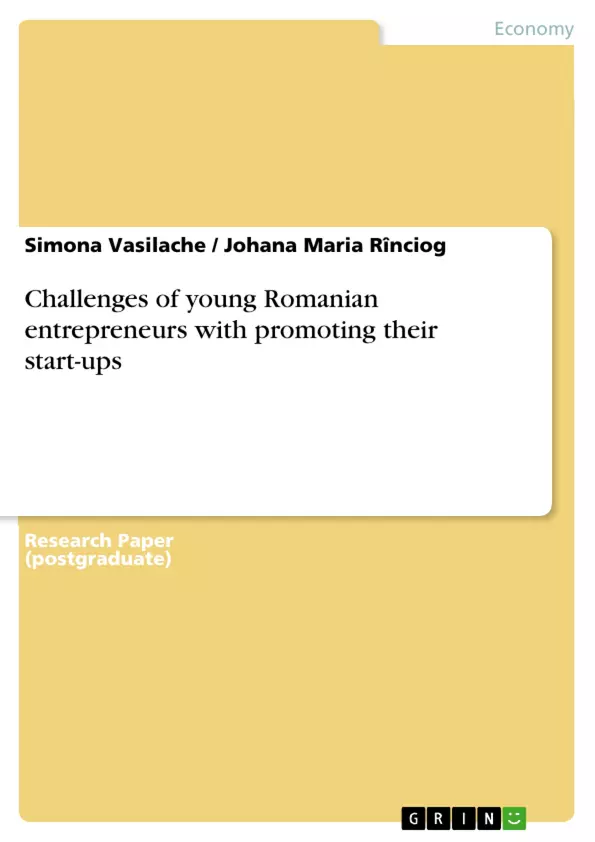In the first chapter of this study we aimed to perform a deeper research regarding the main challenges faced by young entrepreneurs. We used the information obtained from discussions with entrepreneurs as a basis for our research, in order to search for more ideas and details in books and articles dedicated to this subject. At the end of this chapter we wanted to know exactly which are the main categories of obstacles faced by young entrepreneurs, and the activities they should perform in order to avoid or reduce the negatives effects of these difficulties. Since the subject of our paper is quite broad, we covered in this chapter three aspects:
• Challenges faced by entrepreneurs in general;
• Challenges of promoting a start-up;
• Challenges faced by Romanian entrepreneurs at this moment;
The second chapter of the research was dedicated to present the method of research used for this study. We mentioned previously that we had the opportunity to discuss with many entrepreneurs about the way they succeed to manage their businesses. Since we maintained the contact with them, we wanted to highlight and take advantage of this source of knowledge and experience in order to improve our own knowledge regarding the entrepreneurial experience. Therefore, the purpose of this chapter is to present the way we managed to achieve the aforementioned objective.
The third chapter aims to present the results of our research. We will focus on explaining the way we reached these results and the criteria based on which we selected the most important information obtained from our research. Also, we are interested in obtaining some best practices to be transferred onto other potential entrepreneurs.
Frequently asked questions
What is the table of contents of this language preview?
The table of contents includes: List of Figures and Tables (1), Introduction (2), 1. Theorethical perspective (3), 1.1 Common challenges for new entrepreneurs (4), 1.2 Challenges of promoting a start-up (11), 1.3 Challenges of Romanian Entrepreneurs (15), 2. Methodology (19), 2.1 Interview as a research method (20), 2.2 Descriptive statistics (25), 3. Interviews analysis (29), 3.1 The coding process (30), 3.2 Processing of interviews in Nvivo (36), Conclusions (42), References (45), and Annex (48).
What figures and tables are included in the language preview?
The preview contains: Figure 2: Labeling of the first three questions from the interview (31), Figure 3: Labeling of the questions 4,5,6 from the interview (31), Figure 4: Labeling of questions 7,8,9 (32), Figure 5: The importance of the three categories of codes in the case of Anaide (37), Figure 6: The importance of the three categories of codes in the case of Anaide (38), Figure 7: The importance of 'Difficulties encountered' for all the interviewees (39), Figure 8: The importance of 'Attitude' for all the interviewees (40), Figure 9: The importance of 'Promotional activities' for all the interviewees (41), Table 1: Sources of financing - advantages and disadvantages (7), Table 2: Data about the entrepreneur - Diana Mirea (26), Table 3: Data about the entrepreneur - Bogdan Ivan (26), Table 4: Data about the entrepreneur - Robert Oros (27), Table 5: Data about the entrepreneur - Alexandru Dudulea (28), and Table 6: Data about the entrepreneur - Algayyim Zaid (28).
What are the three parts of the current study, as mentioned in the Introduction?
The study consists of three parts. The first chapter researches the main challenges faced by young entrepreneurs. The second chapter presents the method of research used for the study. The third chapter presents the results of the research.
What are the three role stressors identified by Wincent and Ortqvist (2009)?
Wincent and Ortqvist (2009) identified three role stressors: Role conflict, Role ambiguity, and Role overload.
What are the most common challenges for new entrepreneurs, according to the language preview?
The most common challenges for new entrepreneurs include: Abandoning their job, Finding external funding for their business, Employing the right people and determining them to work as a team, Managing the rapid growth of the business, and Taking care of the administrative tasks of the business, such as setting rules.
What sources of financing for entrepreneurs are mentioned in the table, along with their advantages and disadvantages?
The table presents the following sources of financing: Personal sources, Bank loan, Venture capitalist, Friends and family, and Retained profit. For each source, advantages and disadvantages are provided.
What are the key steps for entrepreneurial ventures regarding promotion?
The key steps include: Chosing a target market, deciding over the way the venture will position in the mind of consumers, building a brand, and establishing the marketing mix.
What are the elements of the marketing mix (the 4Ps)?
The 4Ps of the marketing mix are: Product, Price, Promotion, and Place.
What are some of the constraints and challenges for Romanian entrepreneurs?
Some challenges include: Difficulties obtaining financial resources, and Lack of entrepreneurship education.
What does the study hope to achieve?
The aim of the study is to emphasize the challenges faced by entrepreneurs when they have to promote their business and their products and provide some insight and possible best practices that could be transferred onto other potential entrepreneurs.
- Quote paper
- Simona Vasilache (Author), Johana Maria Rînciog (Author), 2016, Challenges of young Romanian entrepreneurs with promoting their start-ups, Munich, GRIN Verlag, https://www.grin.com/document/336880



